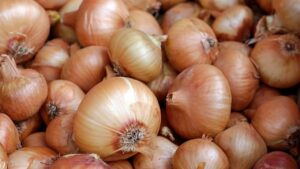THE Department of Agriculture (DA) said it is considering issuing more import clearances for yellow onion and small pelagic fish, citing a drop in supply following recent storms.
“It looks like we are lacking in yellow onions. So, I have given an order to add just 1,000 metric tons (MT),” Agriculture Secretary Francisco P. Tiu Laurel, Jr. told reporters on the sidelines of the KADIWA ng Pangulo Expo on Tuesday.
In August, the DA cleared yellow onion imports of 16,000 MT with supply then reckoned as sufficient to last until the end of that month.
He added that the additional imports should arrive before the end of December, with the domestic onion harvest expected to start by February next year.
Yellow onion stocks totaled 1,796.9 MT, according to the Bureau of Plant Industry as of Nov. 22. Most of the inventory consisted of imports.
Mr. Laurel has said that the DA is also studying importing a small quantity of carrots, tomatoes, and broccoli to curb possible price increases after roads used by vegetable farmers were damaged by the typhoons.
“There is a chance that we will no longer import (other vegetables),” Mr. Laurel said.
Additionally, the DA said it will allow imports of an additional 8,280 MT of small pelagic fish.
Mr. Laurel said that the imported fish must be landed by the end of January next year, taking into consideration the timing of the end of fishing bans in key fisheries.
“Our closed fishing season ends on Jan. 30 in Palawan, but the lifting of the season in Zamboanga is not until the end of February,” he added.
Republic Act No. 8550 or the Fisheries Code authorizes closed fishing season to help stocks regenerate. Closed season typically starts in November and can run until March in some areas.
The DA will issue Sanitary and Phytosanitary Import Clearances for fish imports until Dec. 16.
The DA had earlier authorized imports of 30,000 MT of round scad (galunggong), mackerel, bonito, and moonfish.
He added that 280 MT of fish will be allocated for the KADIWA network of subsidized stores, where goods typically cost 20% less than in public markets. — Adrian H. Halili

